2nd Edition | J-drama Food:
What's That They're Eating? | Here I am again with another drama food post. This time we will be going over foods and drinks commonly seen in Japanese dramas. Unlike the Kdrama Food article, I decided to skip the drama stillshots (they're a pain anyway) and let the imagery just focus on the food. The glorious, glorious food. As you may or may not know, Japanese food usually is on the more simplistic side. That's not to say it's boring or lacking in flavor by any means. Rather than bring a bunch of ingredients together to create a taste with depth, each ingredient is meant to hold its own and be acknowledged. So, you'll find that food in Japan tends to not have many ingredients compared to food in other Asian countries. The great thing about this (at least for me) it is allows one to eat many different things together without them interfering with each other. It's why I was able to try most of the things listed below on my visit to Japan without getting a bellyache. I seriously wanted to eat myself silly, but didn't only because I had such a hard time choosing among the vast array of yummy options I encountered. Now, time for the food! |
|
Pan | 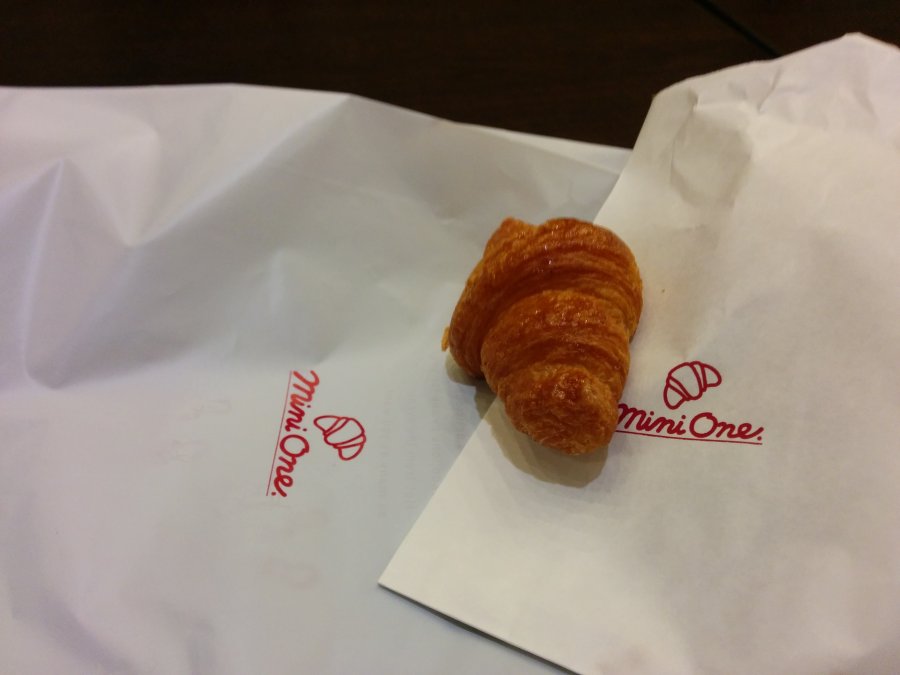 | Pan is the word for bread in Japan. Surprisingly, it's quite popular there with lots of to-go places where you can stop in to pick up some bread items quickly. The picture above is of some farewell bread my penpal got me at the train station before I got on the train from Kyoto to Tokyo. You've more than likely seen characters in dramas getting packaged bread items from convenient stores and/or at high school cafeterias. One thing to know is that what they call bread is quite different from what people in the Western world call bread. Something that was an unpleasant surprise for me was that all the bread is pretty much sweet. That's right. Be it rolls, sliced bread, croissants... there will be some slight sweetness. If you know Hawaiian rolls, yea, just like that. Sometimes even sweeter. The exception is the bread that comes on a sandwich. And you can also find um, er, savory bread in grocery stores. But you still need to pay close attention to the packages to make sure you're getting what you really want. Trust me. Pay. Close. Attention. There are 3 types of pan that you'll probably see often in dramas: | Anpan | 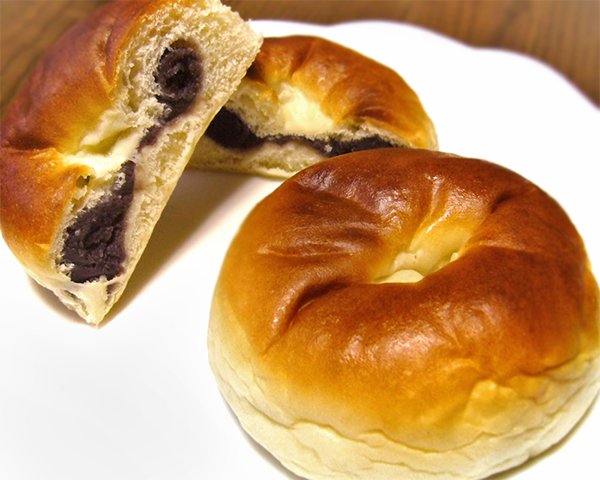 | 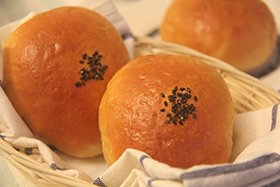 Basically, a big dinner roll with filling. Is that too simple? Well, I told you that's how it was going to be. The bread is dense and a bit chewy with a smooth outer texture, but crumbly interior. The standard filling is azuki (red beans) paste, however you can also find ones with fillings like uguisu (green beans) and kuri (chestnut). Basically, a big dinner roll with filling. Is that too simple? Well, I told you that's how it was going to be. The bread is dense and a bit chewy with a smooth outer texture, but crumbly interior. The standard filling is azuki (red beans) paste, however you can also find ones with fillings like uguisu (green beans) and kuri (chestnut).
|
Melonpan | 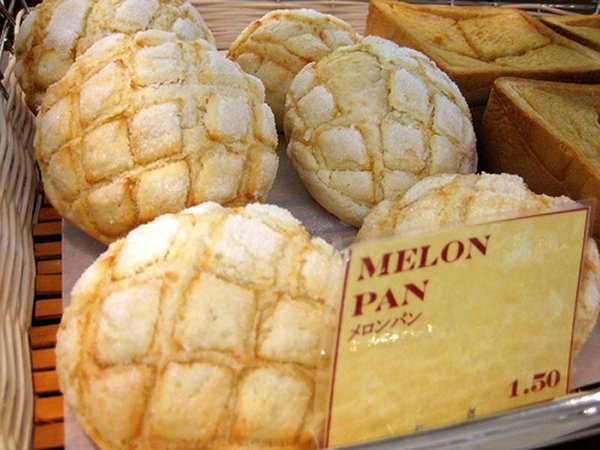 | 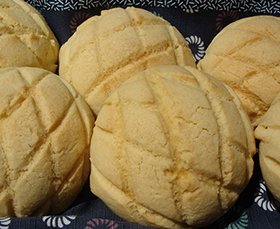 Contrary to popular belief by many foreigners, there is no melon in melonpan. Why is called that then? Because they felt the crosshatch pattern across the top makes it looks like a musk melon (cantaloupe). A perplexing aspect of this pan is that it is actually part cookie. The outer portion with the pattern is a thin layer of cookie dough encasing bread dough. Even more perplexing is with all the bread they make sweet, the bread dough in this is not. "Huh?", is what I said upon first bite. Contrary to popular belief by many foreigners, there is no melon in melonpan. Why is called that then? Because they felt the crosshatch pattern across the top makes it looks like a musk melon (cantaloupe). A perplexing aspect of this pan is that it is actually part cookie. The outer portion with the pattern is a thin layer of cookie dough encasing bread dough. Even more perplexing is with all the bread they make sweet, the bread dough in this is not. "Huh?", is what I said upon first bite.
While I wasn't too keen on the combination, I was overjoyed to have found some non-sweet bread to dip in my soup later. |
Currypan | 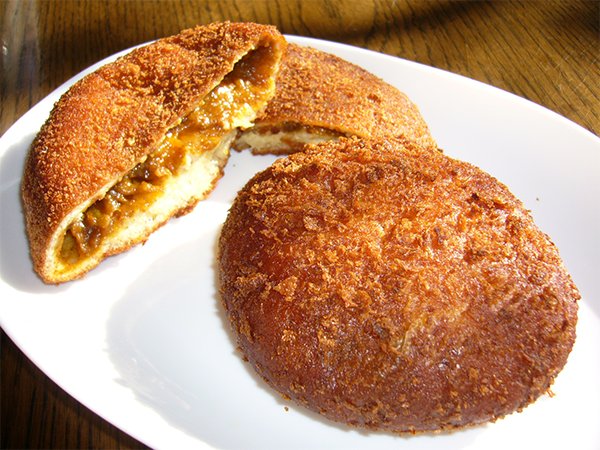 | 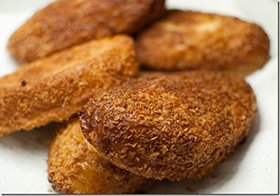 Similar concept to anpan except it's a curry filled dough that's been deep-fried. There's a good chance you could mistake this for something like chicken kiev or fried meat given the exterior appearance. That would be due to the breading of the bread. Yep, they bread... bread. So, if you find yourself at a fried food stand or in one of the wonderful hot food markets at the bottom of department stores, and you feel like you can't find the currypan, make sure to ask for it. Similar concept to anpan except it's a curry filled dough that's been deep-fried. There's a good chance you could mistake this for something like chicken kiev or fried meat given the exterior appearance. That would be due to the breading of the bread. Yep, they bread... bread. So, if you find yourself at a fried food stand or in one of the wonderful hot food markets at the bottom of department stores, and you feel like you can't find the currypan, make sure to ask for it.
|
|
|
Streetfood | 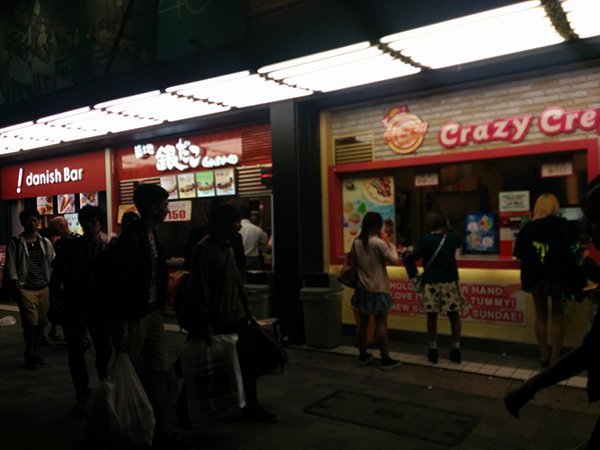 | A definite highlight to any trip abroad, streetfood in Japan is abundant. Remember me saying I wanted to eat myself silly? This is how I would have done so. Just about anywhere I went in the city, I was never that far from a quaint stand where could I grab something tasty. This is typically the case in Japanese dramas, as well. Especially in date or work lunch scenes. Streetfood was my lifeline in Tokyo since I was there alone and it felt odd eating alone in restaurants. I took the picture above in Akihabira, anime central. | Takoyaki | 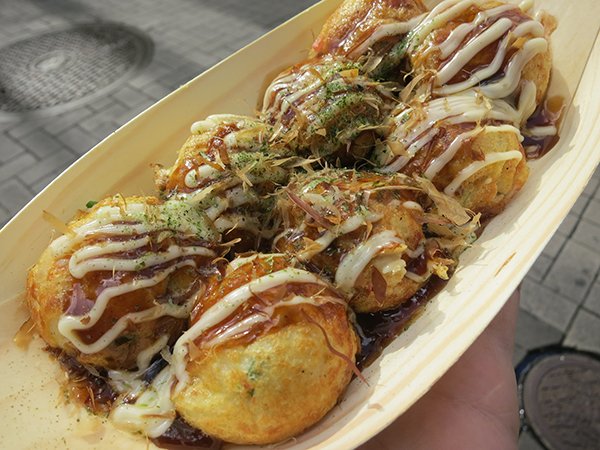 | 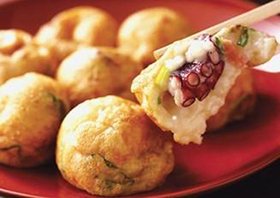 Tako means octopus, while yaki means "to grill." Very similar to ebelskivers, dough is poured onto a hot griddle with rounded pockets. Pieces of octopus are nestled in the batter before being topped off. Once the bottom is mostly cooked through, you flip ball in the rounded pocket to finish cooking. They are served hot and can come with a variety of toppings. Most common toppings are takoyaki sauce (like Worcestershire sauce), bonito (shaved fish flakes), kewpie (Japanese mayo), and aonori (dried seaweed). Tako means octopus, while yaki means "to grill." Very similar to ebelskivers, dough is poured onto a hot griddle with rounded pockets. Pieces of octopus are nestled in the batter before being topped off. Once the bottom is mostly cooked through, you flip ball in the rounded pocket to finish cooking. They are served hot and can come with a variety of toppings. Most common toppings are takoyaki sauce (like Worcestershire sauce), bonito (shaved fish flakes), kewpie (Japanese mayo), and aonori (dried seaweed).
Let me tell you that not all takoyaki are created equally. Get it from a takoyaki stand or somewhere they makes it fresh as you order it. If it's in a package, be prepared with lowered expectations. Below are pictures I took of them being made. | |
Yakisoba | 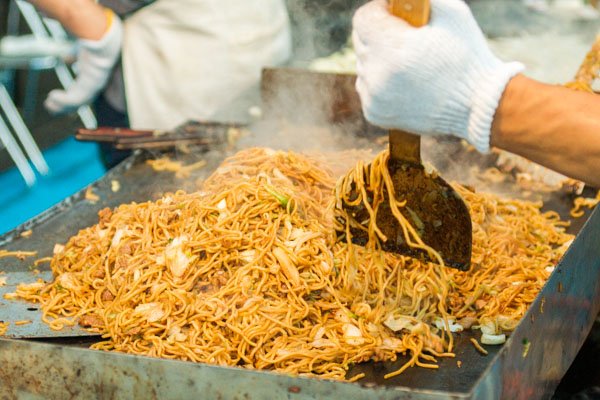 |  Based on chow mein, yakisoba a dish of ramen noodles, cabbage, carrots, and sometimes meat in a thick sauce. Dramas that have a beach setting or beach scenes tend to include yakisoba. Even though it's eaten all year long, it tends to coincide with summer just like watermelon and ice cream. It is the Japanese Summer equivalent to the American hot dog —even in a literal sense. Based on chow mein, yakisoba a dish of ramen noodles, cabbage, carrots, and sometimes meat in a thick sauce. Dramas that have a beach setting or beach scenes tend to include yakisoba. Even though it's eaten all year long, it tends to coincide with summer just like watermelon and ice cream. It is the Japanese Summer equivalent to the American hot dog —even in a literal sense.
In your Jdrama watching, you may have seen what's called a yakisobapan. Ok, using the knowledge you learned above I'm sure you can conclude what that is. You got it, it's yakisoba in bread. More accurately, it is yakisoba sandwiched in a bun like a hot dog. While curious, I couldn't bring myself to spend my precious yen on what to me looked like an abomination up close. I'll stick to yakisoba on a plate. |
Taiyaki | 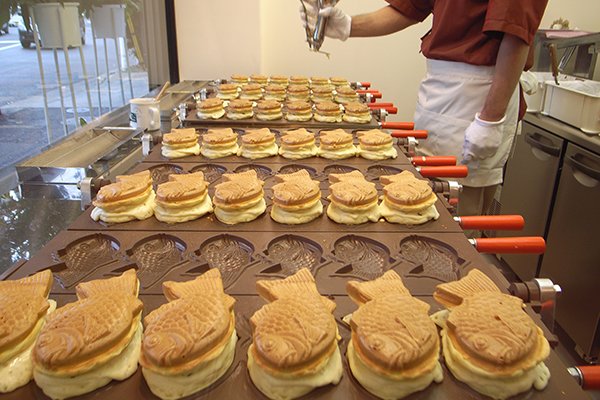 |  Edible joy (shokuyo no yorokobi). That's what I called this to the kind man that served me at the stand. It's made in the same fashion as takoyaki except griddle plates have fish shaped molds in them and the batter is a bit different. Takoyaki batter consistency = pancake. Taiyaki batter consistency = waffle. It's also a bit sweet, while takoyaki batter is savory. What's also different is usually two sides are used to make taiyaki. Two rows of molds are filled with batter. When one row sets a bit, the filling is placed and then the adjacent row of molds is flipped on top of the row with the filling. Edible joy (shokuyo no yorokobi). That's what I called this to the kind man that served me at the stand. It's made in the same fashion as takoyaki except griddle plates have fish shaped molds in them and the batter is a bit different. Takoyaki batter consistency = pancake. Taiyaki batter consistency = waffle. It's also a bit sweet, while takoyaki batter is savory. What's also different is usually two sides are used to make taiyaki. Two rows of molds are filled with batter. When one row sets a bit, the filling is placed and then the adjacent row of molds is flipped on top of the row with the filling.
Common fillings are the azuki paste, custard, and chocolate. Custard was my choice and I was so anxious to eat it that I forgot to take a picture. I was happily kicking my feet the whole time. You can find these easily in most shopping arcades. I recommend getting one when you have room in your belly or with a couple of people so you can try an assortment of fillings. |
|
|
Restaurant | I was having a hard time trying to come up with the best way to categorize these and restaurant seemed like a good catch-all. You'll mainly find the foods below in sit-down places. That's really the only pre-requisite; sitting. The style of restaurants run the gamut of sitting at a counter that can only seat 5 people to sitting on the floor at a griddle or chabudai to your run-of-the-mill table/chairs place. This is food that you allow some time for. | Okonomiyaki | 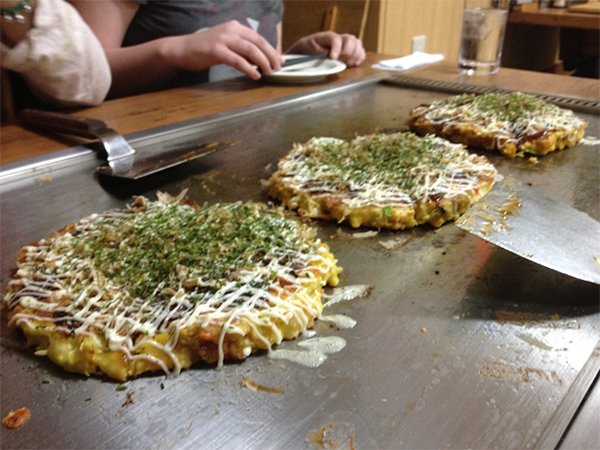 | 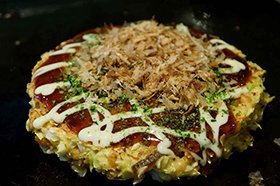 Review time again. So, you should know what yaki means. Can you guess what you would be sitting at for eating this food? If you guessed griddle, then you would be right. Ah, you learn so fast. The okonomi part means "however you want", which is exactly how you can get your okonomiyaki. It's a delicious savory pancake to which you can add a myriad of toppings and fillings. Review time again. So, you should know what yaki means. Can you guess what you would be sitting at for eating this food? If you guessed griddle, then you would be right. Ah, you learn so fast. The okonomi part means "however you want", which is exactly how you can get your okonomiyaki. It's a delicious savory pancake to which you can add a myriad of toppings and fillings.
I make this at home and have actually gotten quite good at it (tooting away on my horn). But it couldn't hold a candle to what I had at an okonomiyaki restaurant in Kyoto (pic below). The dish hails from the Kansai area which includes Kyoto and Osaka, and is very popular there. It's the place to experience a wide variety, and have it made by seasoned vets. The base of the pancake is shredded cabbage, chopped green onions, okonomi flour mix (flour + grated nagaimo), eggs, and dashi. You could mix just all of them together and throw it on the griddle, or you could add some bits of seafood. Once you place it on the griddle, you add strips of pork belly to the top (I use bacon) and wait for the bottom to set before you flip it. After both sides are done, the standard toppings are okonomi sauce, kewpie mayo, bonito, and aonori. Sound familiar? (see: takoyaki) But you don't have to stop at just one level of pancake before adding toppings. Some people add more of the cabbage mixture on top of the bacon, more meat/seafood, and sometimes even cooked noodles. All of it resulting in a small mound of blissful gluttony. It's okonomi! Have at it. | 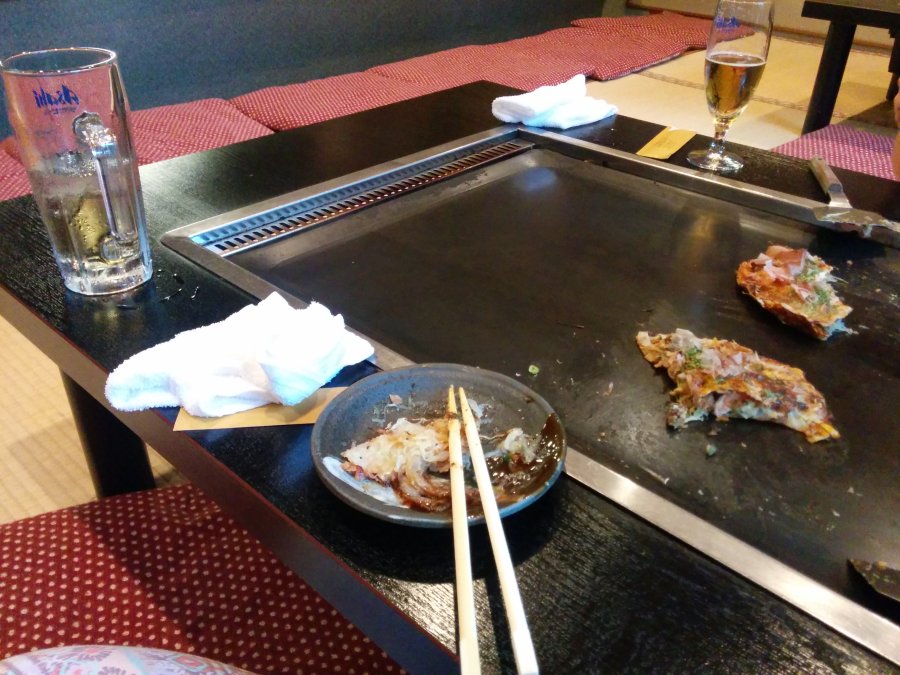 |
Omurice |  | 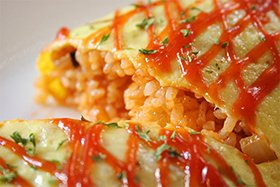 A combination of the English words omelet and rice, and literally what the dish mainly consists of. Stir-fried tomato rice is enveloped within a fluffy plain omelet, adorned with ketchup, served on a plate, and eaten with a spoon. What's interesting is omurice is considered Western-style food in Japan. The closest Western food I could think of to this was huevos rancheros since there aren't many countries in this hemisphere that traditionally eat eggs with rice. Western-inspired then? Like how they eat fried chicken and cake on Christmas there? Speaking of fried chicken... A combination of the English words omelet and rice, and literally what the dish mainly consists of. Stir-fried tomato rice is enveloped within a fluffy plain omelet, adorned with ketchup, served on a plate, and eaten with a spoon. What's interesting is omurice is considered Western-style food in Japan. The closest Western food I could think of to this was huevos rancheros since there aren't many countries in this hemisphere that traditionally eat eggs with rice. Western-inspired then? Like how they eat fried chicken and cake on Christmas there? Speaking of fried chicken...
|
Karaage |  | 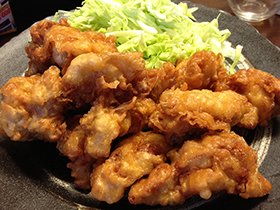 While I still maintain Korea as ranking supreme when it comes to fried chicken, Japan can bring a bit of thunder, too. Main reason being that Japan ranks supreme in fried food overall (unofficial survey of 1). I am convinced there is some type of artform to the way they fry foods. If you're familiar with tempura, then you know what I mean. Karaage is actually the name for the technique used to fry foods, like tempura is a technique. Palm-sized pieces of chicken (can be pork and fish too) are marinated in a mixture of soy sauce, garlic, and ginger before being dredged in a seasoned flour mix and then fried in a light oil. Regardless of the meat, it's usually served with lemon wedges. While I still maintain Korea as ranking supreme when it comes to fried chicken, Japan can bring a bit of thunder, too. Main reason being that Japan ranks supreme in fried food overall (unofficial survey of 1). I am convinced there is some type of artform to the way they fry foods. If you're familiar with tempura, then you know what I mean. Karaage is actually the name for the technique used to fry foods, like tempura is a technique. Palm-sized pieces of chicken (can be pork and fish too) are marinated in a mixture of soy sauce, garlic, and ginger before being dredged in a seasoned flour mix and then fried in a light oil. Regardless of the meat, it's usually served with lemon wedges.
|
Hambagu | 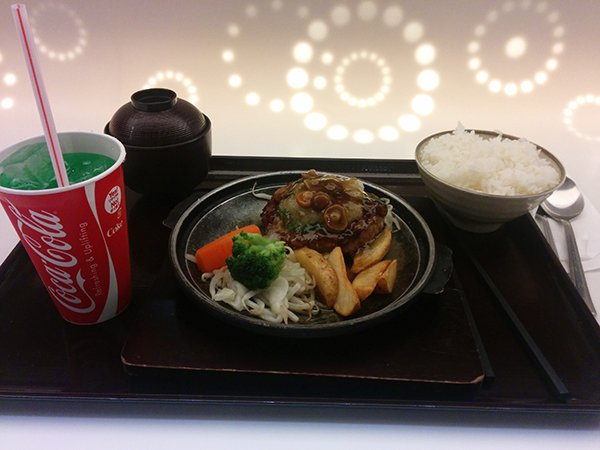 |  As I'm sure you've surmised, hambagu is what the Japanese call hamburgers. However, it is a general term used to refer to a grilled patty of beef. You have your actual Western-style hambagu from places like Burger King and McDonald's, then you have your not-quite-so-Western-style hambagu that is pictured above. The pic above is of my hambagu meal at the Skytree food arcade and similar to how your not-quite-so-Western-style will likely be served at a restaurant. As you can see, it's more so along the lines of Salisbury steak. Your actual Western-style hambagu, you'll find at fast food spots. As I'm sure you've surmised, hambagu is what the Japanese call hamburgers. However, it is a general term used to refer to a grilled patty of beef. You have your actual Western-style hambagu from places like Burger King and McDonald's, then you have your not-quite-so-Western-style hambagu that is pictured above. The pic above is of my hambagu meal at the Skytree food arcade and similar to how your not-quite-so-Western-style will likely be served at a restaurant. As you can see, it's more so along the lines of Salisbury steak. Your actual Western-style hambagu, you'll find at fast food spots.
|
Kushikatsu | 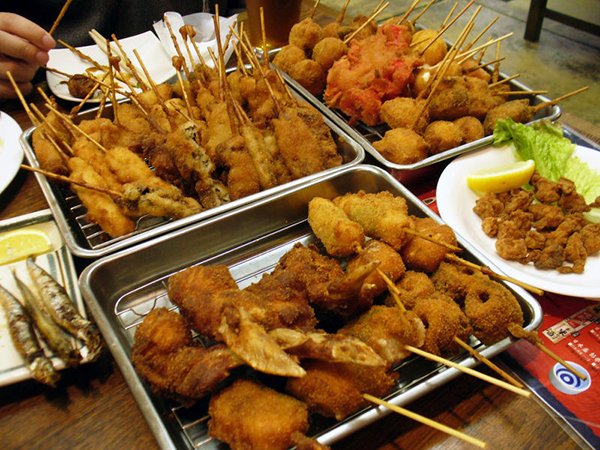 | 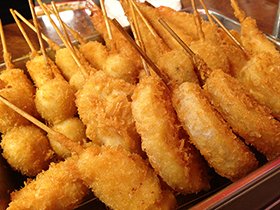 Back to the topic of fried food, kushikatsu is the perfect versatile small plate. It works as an appetizer for a larger meal, accompaniment for drinking, or as a light snack. It is skewers of meat, fish, or vegetables dipped in egg, flour and panko, then fried in vegetable oil. Back to the topic of fried food, kushikatsu is the perfect versatile small plate. It works as an appetizer for a larger meal, accompaniment for drinking, or as a light snack. It is skewers of meat, fish, or vegetables dipped in egg, flour and panko, then fried in vegetable oil.
I had a tall glass of cider draft and two sets of kushikatsu since I wanted to try a bunch of different types. There was lotus root, various fish, chicken, and pork. All of them were great, but I liked the seafood ones the best. Again, I, unfortunately, didn't think to take a photo until after I was done. Does the empty plate convey how good they were? | 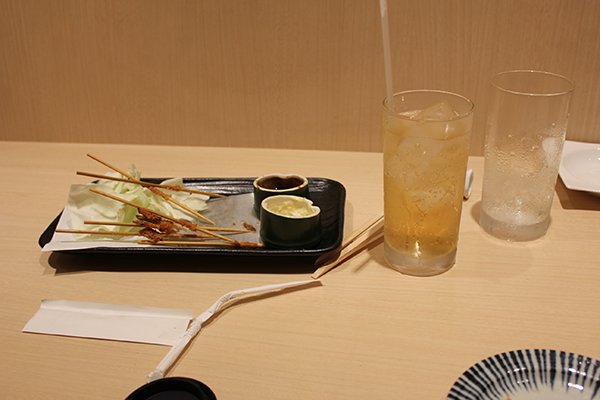 |
|
|
Foods in Broth | This category really doesn't need much of an intro. By now, you can see that I really meant it earlier when I said Japanese food was simple. Foods in broth is plain and simply foods in broth. | Ozoni | 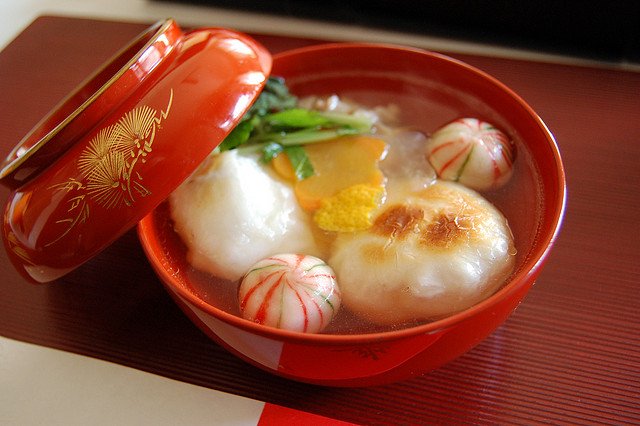 | 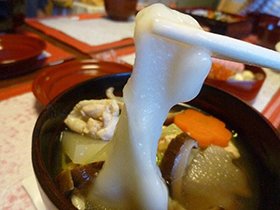 There's a running gag (no pun intended) in Japan about not eating ozoni alone as not to choke and die. It may seem a bit cruel, but it serves as a warning that's easy to remember and prevents many deaths. You see, ozoni is a soup of thin broth, a few veggies, and a square of grilled mochi. Mochi is already rather viscous, but the heat from the broth makes it stretchy like melted mozzarella cheese. In that state, the risk of choking on the mochi is heightened. There's a running gag (no pun intended) in Japan about not eating ozoni alone as not to choke and die. It may seem a bit cruel, but it serves as a warning that's easy to remember and prevents many deaths. You see, ozoni is a soup of thin broth, a few veggies, and a square of grilled mochi. Mochi is already rather viscous, but the heat from the broth makes it stretchy like melted mozzarella cheese. In that state, the risk of choking on the mochi is heightened.
Ozoni is most commonly eaten on New Year's day. Every year there are reports of a few deaths caused by people choking on the mochi, hence the joke/warning. There are tons of people that eat ozoni with no problem, but don't be surprised if while eating ozoni in Japan people around you constantly remind you to chew it thoroughly and eat slowly. |
Nabe | 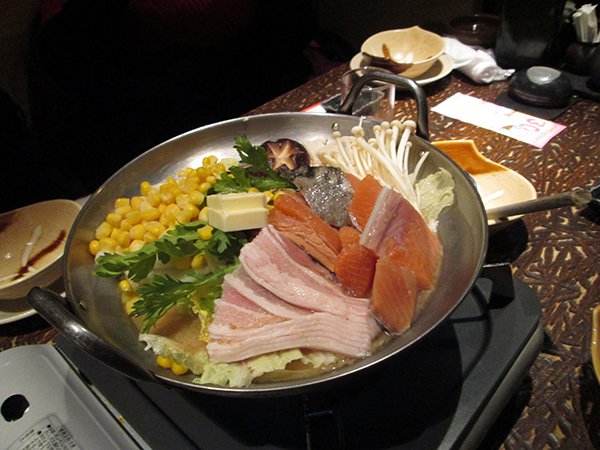 | 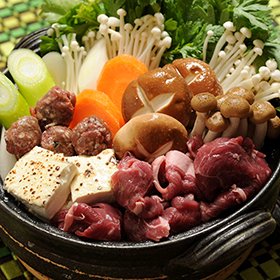 The Japanese version of hotpot, nabe is common way to quickly feed an unexpected small group of people. It's a general term that refers to a handful of stews and soups that are cooked in a clay or cast iron pot and prepared at the table. People make it at home often, especially during the winter months. The Japanese version of hotpot, nabe is common way to quickly feed an unexpected small group of people. It's a general term that refers to a handful of stews and soups that are cooked in a clay or cast iron pot and prepared at the table. People make it at home often, especially during the winter months.
You start with broth that is typically made with miso, soy sauce, dashi, and/or sake. Once the broth comes to a boil, you add in veggies. Meat is added a little later if it's going to be used. There are various main varieties and a number of regional varieties. |
Oden |  | 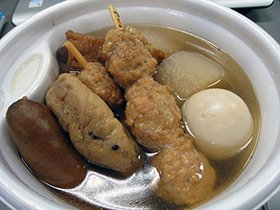
This falls under the Nabe umbrella. A wide variety of items are simmered in a light dashi broth until tender before eating. People usually drink the broth after all the solid foods have been eaten. As you can imagine, Oden is a common winter food and you can find it at dedicated restaurants, streetfood carts, convenience stores, and cans in vending machines. Some typical oden items are: Tsukune (fish ball), Yude Tamago (hard boiled eggs), Tako (octopus), Aburaage (deep fried tofu), Kamaboko (cured seafood product), Suji (beef tendons), Shiitake (type of mushroom), and Roru Kyabetsu (cabbage roll). |
|
|
Snacks | Dango | 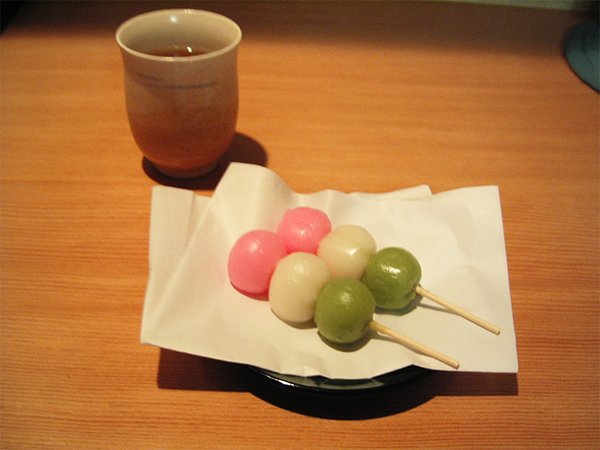 | 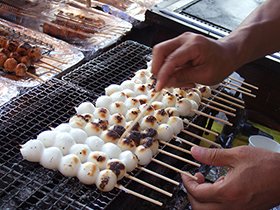 Dango are little gelatinous dumplings made from sweet mochi flour. They are commonly eaten as snacks to accompany tea, but come in such a wide variety of flavorings and seasonings that they can be eaten with almost anything. Mitarashi dango (covered in sweet soy sauce) is the general type that's common at grocery and convenience stores, as well as snack shops. You'll usually find them skewered, served room temperature or cold. Dango are little gelatinous dumplings made from sweet mochi flour. They are commonly eaten as snacks to accompany tea, but come in such a wide variety of flavorings and seasonings that they can be eaten with almost anything. Mitarashi dango (covered in sweet soy sauce) is the general type that's common at grocery and convenience stores, as well as snack shops. You'll usually find them skewered, served room temperature or cold.
Mitarashi has actually been the only type I've had and it took some getting used to before I could genuinely come to like it. I like mochi period, but if I wanted it outside of ice cream in Chicago, dango was my best option and Mitarashi was all I could find. So, I acquired the taste. I didn't choose the dango life, the dango life chose me. |
Manju | 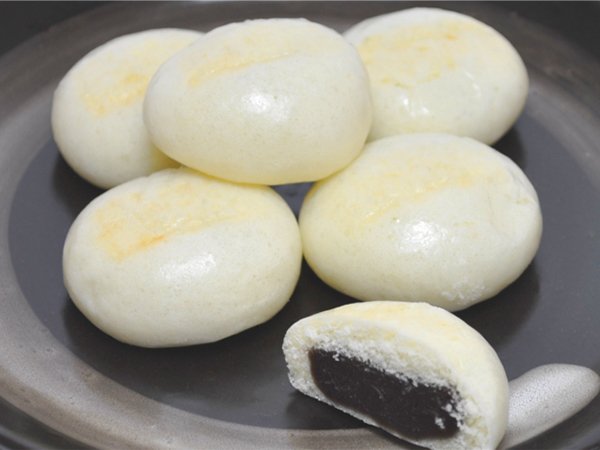 | Manju, manju, manju! The best way to think about manju in general is as a bready mochi. A steamed bready mochi to be more exact. The outer part is similar to the Chinese steamed dumplings called bao, but they are a litte chewier. Azuki paste is the standard filling, and they are sold at pastry shops or dedicated shops. The jdrama that actually inspired me to choose Asakusa as my home base during my trip to Tokyo was set in a Wagashi store in that area (Ando Natsu). I learned a lot about wagashi and the important role it plays in the Japanese tea ceremony. There are quite a few different types of manju, but there are couple that stand out to me. | 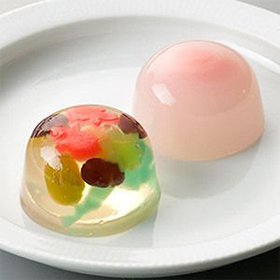 Mizu manju Mizu means water and the name is based on the translucent quality this type of manju possesses, which is achieved by the use of kuzu starch. The opacity can range, but it's the ones with a completely transparent exterior that are usually impressive. The consistency is more mochi-like compared to other variations of manju, but not as chewy. The texture is akin to firm gelatin. Mizu manju Mizu means water and the name is based on the translucent quality this type of manju possesses, which is achieved by the use of kuzu starch. The opacity can range, but it's the ones with a completely transparent exterior that are usually impressive. The consistency is more mochi-like compared to other variations of manju, but not as chewy. The texture is akin to firm gelatin.
| 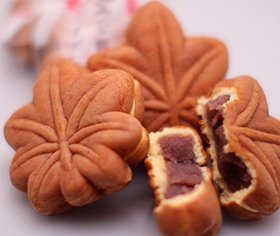 Momiji manju This variation of manju is unique to the Hiroshima and Miyajima regions. Momiji means maple leaves, the name being an accurate description of the shape in which the manju is made. While it may remind you of taiyaki, it has different qualities. It's made with a dough as opposed to batter, and the resulting cake has a sponge texture. Also, they are fried instead of being made in a griddle. What it does have in common with taiyaki are the fillings (azuki paste, custard, etc.) Momiji manju This variation of manju is unique to the Hiroshima and Miyajima regions. Momiji means maple leaves, the name being an accurate description of the shape in which the manju is made. While it may remind you of taiyaki, it has different qualities. It's made with a dough as opposed to batter, and the resulting cake has a sponge texture. Also, they are fried instead of being made in a griddle. What it does have in common with taiyaki are the fillings (azuki paste, custard, etc.)
|
|
Inarizushi | 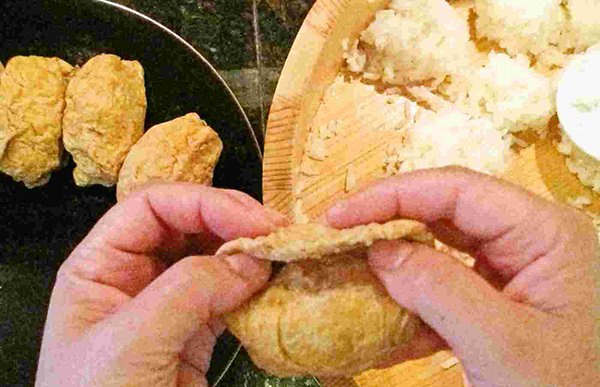 | 
If you've ever been watching a program in Japanese with subtitles, and have seen the phrase "fake suhi", this is what they were referring to. It's seasoned sushi rice that is stuffed into an aburaage pouch. Aburaage has a slightly sweet flavor, and with the rice it's a... interesting flavor. If you're a fan of things like mango with sticky rice, then this will probably be right up your alley. The name comes from the Shinto god Inari. The mythical legend claims that Inari had a strong affinity for fried tofu, so you'll often see kistune (typical fox spirit messengers for Inari) being associated with aburaage and/or inarizushi. The term "fake sushi" is due to the fact that while it's technically sushi (sushi means with rice), it doesn't get to hang out with all the other types of sushi. You won't find it at sushi shops, but you can get them at okazuya (deli's). Kind of like the cat story from the Chinese zodiac, poor little outcast. Below is a picture of an assortment of fried goodies I bought from a street stand. | 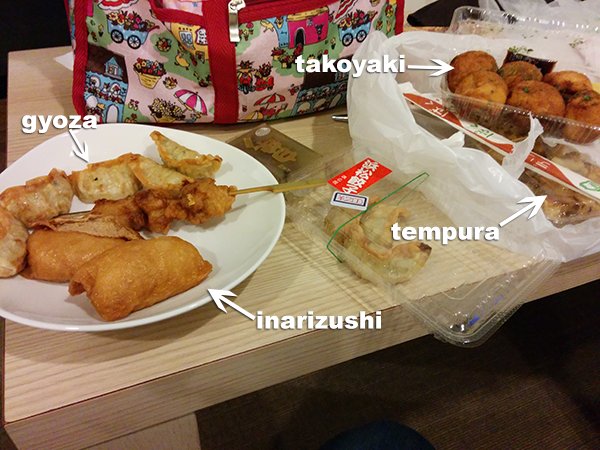
|
Peaches | 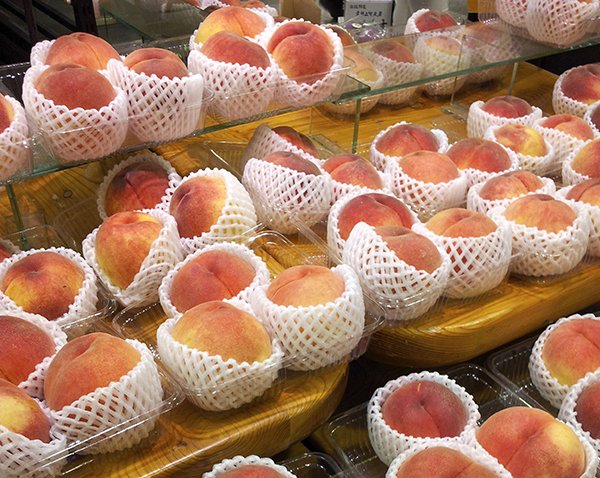 | 
Yes, peaches. Bewildered? Don't be, 'cause the peach game in Japan is on another level. They are light pink and heart-like in shape. They have a delicate sweetness and firm texture. They are heavenly. They are not inexpensive. If you read my Kdrama post, you're already in the know about needing a designated fruit budget when you go to South Korea. Same goes for Japan. I didn't know how much hospitality my penpal was showing me when he put out a bowl of cut peaches and kiwi until I wanted to buy some myself. One peach was like 680¥ (about $6), yikes! I had a fixed amount of yen and couldn't justify spending that much on just one piece of fruit, so I had to reluctantly go without another slice of heaven. Woe was I. | 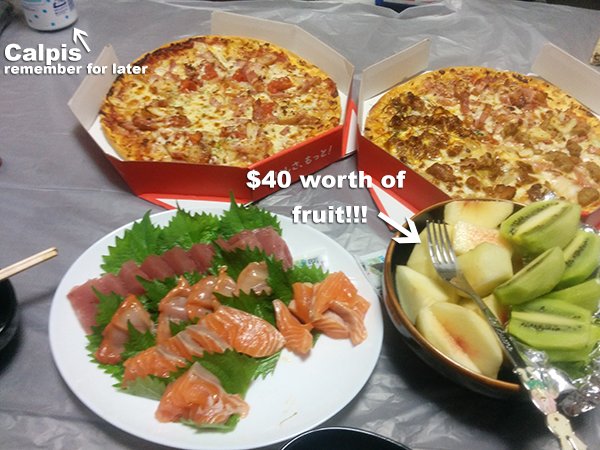
|
|
|
Beverages | This section will be short on the descriptions. I almost didn't include beverages, but I felt there were some worth mentioning. | Amazake | 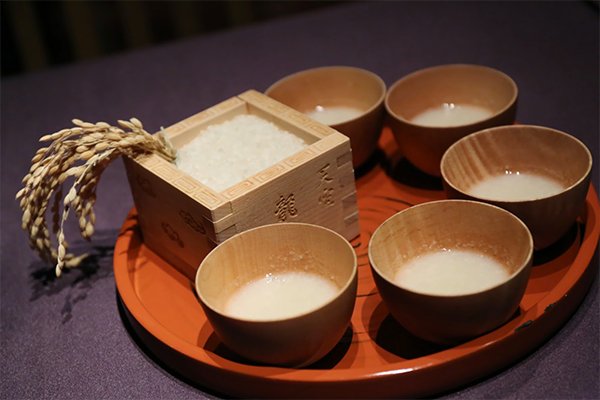 | 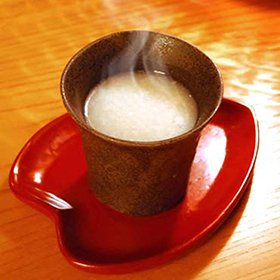 Amazake is a sweet nutritious fermented rice drink that can be low in alcohol (think wine cooler) or non-alcoholic. It's served warm and during the winter. It's typically sold at shrines during New Year's gatherings. Amazake is a sweet nutritious fermented rice drink that can be low in alcohol (think wine cooler) or non-alcoholic. It's served warm and during the winter. It's typically sold at shrines during New Year's gatherings.
|
Soda |  | 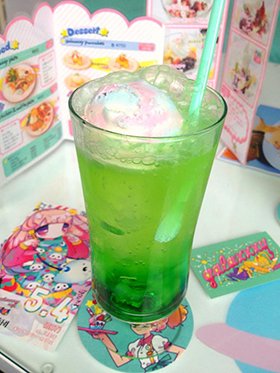 Soda in Japan has its own lifestyle. When ordering a soda at a restaurant, there are a few things you should be mindful of: Soda in Japan has its own lifestyle. When ordering a soda at a restaurant, there are a few things you should be mindful of:
- If it is flavored, it will be neon-colored
- It will somewhat taste like the flavor it claims
- It will be incredibly sweet
- Depending on where you are, it will come with a scoop of ice cream by default
Knowledge is power, my friend. |
Mugicha | 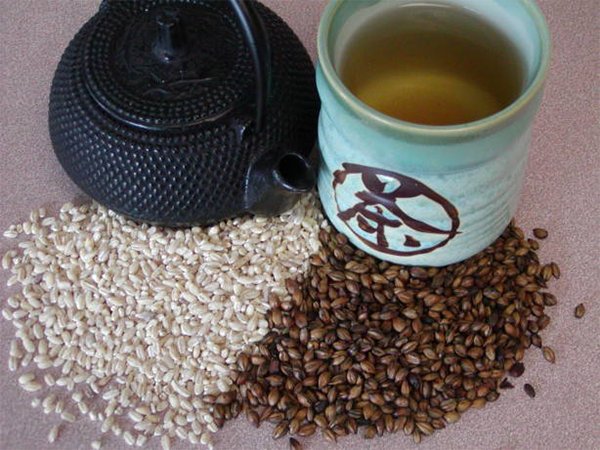 | 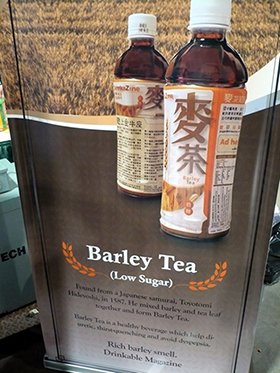 Muchigha is roasted barley tea and has a vast amount of health benefits. However, if you aren't used to drinking unsweetened tea, it tastes like water that got into a fight with a tree, lost, and is seriously bitter about it all. A small spoonful of honey definitely helps, but it still may take some getting used to the bitterness. Muchigha is roasted barley tea and has a vast amount of health benefits. However, if you aren't used to drinking unsweetened tea, it tastes like water that got into a fight with a tree, lost, and is seriously bitter about it all. A small spoonful of honey definitely helps, but it still may take some getting used to the bitterness.
|
Matcha tea | 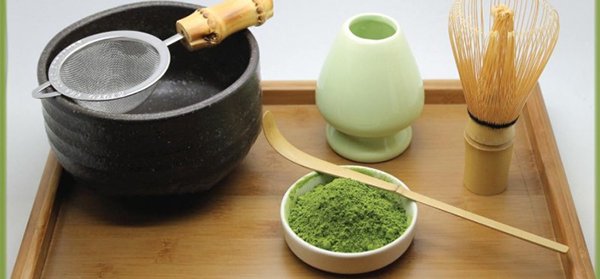 | 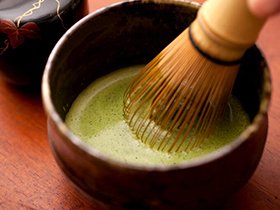 This is the tea that is made and served during Japanese tea ceremonies. Matcha tea means powdered tea, which is mixed with hot water using a special brush to create the drink. The tea is revered for its strong health benefits since unlike other teas that are brewed from leaves, you are actually ingesting the leaf itself in powder form. So, even though it is a green tea, it's not to be confused with what is generally referred to as green tea. This is another tea that can take some getting used; both the bitterness and the thick frothy texture. This is the tea that is made and served during Japanese tea ceremonies. Matcha tea means powdered tea, which is mixed with hot water using a special brush to create the drink. The tea is revered for its strong health benefits since unlike other teas that are brewed from leaves, you are actually ingesting the leaf itself in powder form. So, even though it is a green tea, it's not to be confused with what is generally referred to as green tea. This is another tea that can take some getting used; both the bitterness and the thick frothy texture.
|
Calpis | 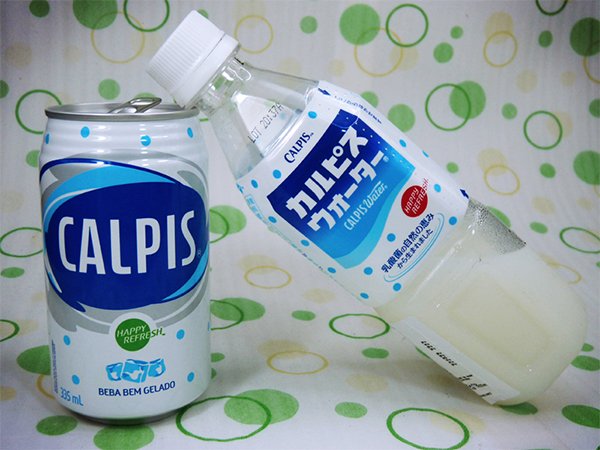 | 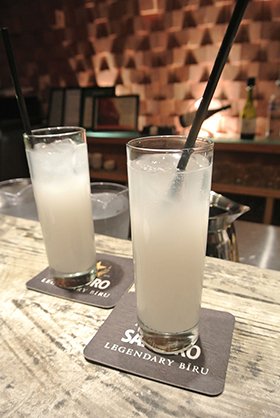 This drink made the list because I had never seen in it a drama (or even anime), but it is wildly popular in Japan. And I do mean wildly. Being that there are plenty of Jdramas I've never watched, I figured it probably lies somewhere in the unwatched since I couldn't come up with any other reason as to why something as ubiquitous as tea was completely unknown to me until I got to Japan. This drink made the list because I had never seen in it a drama (or even anime), but it is wildly popular in Japan. And I do mean wildly. Being that there are plenty of Jdramas I've never watched, I figured it probably lies somewhere in the unwatched since I couldn't come up with any other reason as to why something as ubiquitous as tea was completely unknown to me until I got to Japan.
So, true story. When I visited my penpal's home in Kyoto, he asked me if I wanted some Calpis. Having never heard of the product, I thought he asked me if I wanted some "cow piss." Imagine my look of shock and disgust. Once he had convinced me that he was not trying to serve me some cow's urine, I gave in to accepting a can. Imagine the shock, disgust, and betrayal I felt when I poured it out of the can and it was that thin milky liquid you see here. Lots of explaining to the amusing foreigner took place. At least they enjoyed a good laugh. Now what is this stuff, right? I learned later it is an uncarbonated soft drink comprised of water, dry milk, and lactic acid. Isn't that basically baby formula? I'll be honest and say it doesn't taste like baby formula, but it's a unique taste to which I have nothing to compare. That was my first and last time I experienced such a taste. Wikipedia says it's like Yakult (remember that?). But despite it being made from dry milk, it didn't have a dairy taste to me. I didn't like it (begrudgingly finished the super tall can to be polite) and didn't understand why it was so popular. They even have Calpis flavored KitKats and make cocktails from it. Ah, such is life I guess. | 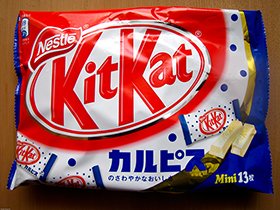 |
|
|
Dessert | What better way to end this list than with what we usually end our meals with, dessert. I'll admit that the last two aren't really in Jdramas (tee hee), so let's consider those bonus picks. They are just too epic not to include when on the topic of food in Japan. | Castella | 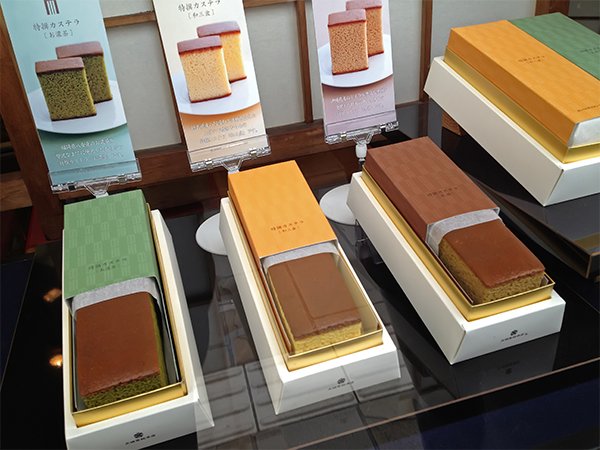 | 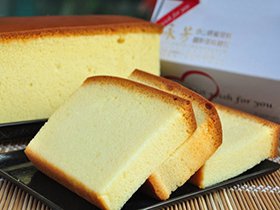 As far as cake goes in Japan, spongecake is the preferred type of cake. And by preferred, I mean really the only choice you have when it comes to buying cake. Christmas cake, wedding cake, birthday cake... it'll be some type of spongecake with frosting. Maybe you'll come across Angel's Food cake, but that's pretty much spongecake, isn't it? Their bread is sweet, and their cake is spongy. If you want cakey cake, your best bet would be a French patisserie. As far as cake goes in Japan, spongecake is the preferred type of cake. And by preferred, I mean really the only choice you have when it comes to buying cake. Christmas cake, wedding cake, birthday cake... it'll be some type of spongecake with frosting. Maybe you'll come across Angel's Food cake, but that's pretty much spongecake, isn't it? Their bread is sweet, and their cake is spongy. If you want cakey cake, your best bet would be a French patisserie.
With that said, Castella is a spongecake, but a dense one. It's the closest you'll come to typical Western style cake as far as density and texture and that's probably because Castella is a Western cake (brought to Japan from Portugal) that is generally made true to the authentic recipe. The name is derived from the Portuguese term Pão de Castella, which means "bread from Castille." It definitely comes across as a lightly sweet bread. From the pictures, it may seem like it resembles pound cake, but it doesn't at all. It firmly lies in the twilight zone between bread and cake. |
Honey Toast | 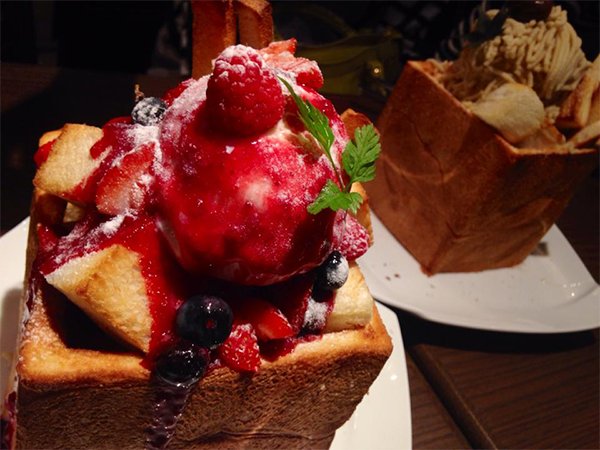 | 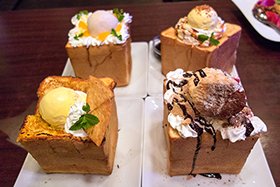 First bonus: Honey Toast. I have always been intrigued, and somewhat befuddled, by this decadent treat. It's essentially an unsliced loaf of White bread that's been toasted and given an array of sweet toppings that are usually reserved for ice cream or cake. I'm a fan of condensed milk toast and feel like honey toast takes it to a whole other level. The loaf can be hollowed out with the pieces toasted and put back in, or it can be left fully intact. The toppings all go on the top and can get outlandish. First bonus: Honey Toast. I have always been intrigued, and somewhat befuddled, by this decadent treat. It's essentially an unsliced loaf of White bread that's been toasted and given an array of sweet toppings that are usually reserved for ice cream or cake. I'm a fan of condensed milk toast and feel like honey toast takes it to a whole other level. The loaf can be hollowed out with the pieces toasted and put back in, or it can be left fully intact. The toppings all go on the top and can get outlandish.
Sadly, when I finally came across a honey toast spot I was already full from my previous meal, and honey toast just doesn't travel well. The worst part was by the time I took the train back to my hotel, my food was digested. My stomach is always trolling me. When I go back to Japan, I'll make a point to better plan out my meals so I can partake in this treat. |
Parfaits | 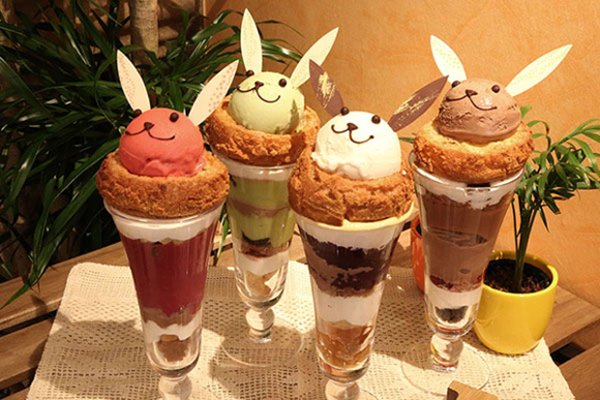 | Japan is known for being eccentric when it comes to some things. Parfaits would be one of those things. When you think you've reached "next level" parfait, you happen upon another one that is outside the atmosphere. They are a thing of beauty in the excessive and the gluttonous. Your standard parfait not doing it for you yet? Let's top it off with a slice of cake! Not enough parfait for you? Let's add another 12 inches! Mena, anata no parfait seikastu shutoku suru! | |
|
|
Well, that's about it. I hope you enjoyed reading about and viewing all the foods despite how long this was. I enjoyed putting it together. Hungry yet? Let me know down in the comments what foods you'd like to try, or what foods are already your favorites. Stay fed, my friends! |
|
 Kdrama Tropes We Love to Hate
Kdrama Tropes We Love to Hate